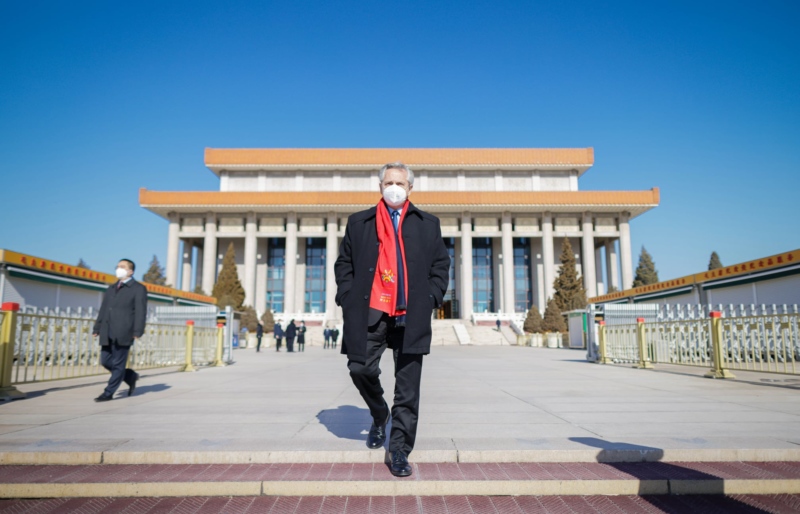The Politics Of Disaster Relief
After a 7.0 magnitude earthquake struck Haiti, the aftershock reached China in ways that few anticipated.The earthquake forced Chinese leaders to navigate the tricky politics of disaster relief.
A Daily Publication of The Dialogue
During his recent visit to China, Argentine President Alberto Fernández signed financing and investment deals worth $24 billion and formally joined the Asian country’s Belt and Road initiative. Just days before, China National Nuclear Corp. announced plans to invest $8 billion in the construction of a nuclear power plant near Buenos Aires. What does Chinese investment mean for Argentina’s energy sector, and what’s in it for China? What might the United States say about China’s increasing inroads in the region? How will Argentina’s neighbors react to this new level of cooperation? Are other Latin American countries expected to sign up for Belt and Road in exchange for billions in investments?
Tara Hariharan, managing director of global macro research at NWI Management LP: “Energy deals between the two countries will most notably expand—with a boost to Argentina’s wind and solar energy sectors, and China seeing increased exports of energy products, services and technology. More broadly, Argentina and China envision closer trade and investment ties, and have grown their bilateral currency swap agreement to augment Argentina’s foreign currency reserves. Peru, Chile and Venezuela are Belt and Road members, as is Ecuador, which is now courting China for a free trade agreement and debt repayment extensions. However, Brazil and Mexico are not yet part of the initiative, and Latin America continues to be torn between economic allegiance to the United States or China. Led by the United States, the G7 nations in mid-2021 launched the so-called ‘Build Back Better World’ public-private initiative, advocating for infrastructure financing based on democratic values that would be more transparent and greener than Belt and Road. To this end, U.S. officials visited Colombia, Ecuador and Panama last fall to explore potential infrastructure investments. The United States may hope to persuade developing nations to disengage from funding by China, whose terms can be predatory, opaque and preempt global lending standards. Besides, China has slowed new Belt and Road investment globally since 2019, perhaps pivoting inward. However, the logistics of funding for Build Back Better World are still uncertain—it remains to be seen whether the United States and its allies can expediently offer Latin America (and emerging markets in general) credible alternatives to Belt and Road’s $3.7 trillion global reach.”
Jorge Heine, research professor at the Pardee School of Global Studies at Boston University, and a former Chilean ambassador to China: “Given that 21 Latin American and Caribbean (LAC) countries are already a part of China’s Belt and Road Initiative, there is nothing surprising about Argentina joining, though it is the largest country in the region to do so thus far. The $24 billion package deal should not be overestimated either, as it includes many ongoing projects. Argentina does have enormous energy reserves, especially natural gas, but it desperately needs foreign investment in the sector. While the announcement of the construction of a new nuclear power plant is controversial, it will be welcome. For China, cementing links with South America’s second-largest country is obviously an attractive proposition. China’s growing presence in Latin America (Sino-LAC trade in 2021 reached $451 billion, a 40 percent increase year on year) does not go down well in Washington. That said, the fact that half of U.S. embassies in the region do not have an ambassador in place (Chile hasn’t had one for four years) would not seem to indicate a great sense of urgency about increasing the United States’ own presence in Latin America. Nature abhors a vacuum. Neighboring countries do not see Chinese investment in Argentina as a zero-sum game. The dominant view is that there is plenty of Chinese capital to go around for everybody, and signing on to Belt and Road, though welcome and actively promoted by Beijing, is not really a prerequisite for Chinese investment. Brazil has not signed on to it, and it has been the main (albeit declining) recipient of Chinese FDI for some time.”
MK Vereen, program assistant for the Energy, Climate Change & Extractive Industries program at the Inter-American Dialogue: “In recent years, Chinese firms have become core investors in Argentina’s renewable energy. For example, in 2020, one of the region’s largest solar plants went online in Jujuy province, having been built and financed by Chinese companies. China also plans to modernize some of the country’s outdated transmission infrastructure, which will enable electricity generated by remote renewable resources to reach Buenos Aires and enhance grid resilience. Such investments will likely increase under the Belt and Road Initiative, as China can provide much-needed finance for Argentina’s emissions-reduction and clean energy goals. While this represents a positive step in the energy transition, these projects must also contribute to sustainable economic development. Chinese-financed renewable energy projects in Argentina are currently developed largely with Chinese technology and human capital, and the state must place a greater priority on knowledge exchange and local job creation to foster green domestic growth. Additionally, if lithium production is increasingly managed by Chinese companies, Argentina may consider similarly adjusting policies to further capitalize on booming demand and to ensure that local communities benefit. Overall, faced with insurmountable debt, Argentina must continue to work with diverse partners going forward, including the United States, the IMF and China. For the United States, there are concerns over China’s intentions in sharing nuclear technologies and increasing its dominance of the lithium-ion battery supply chain. For the IMF, the possibility that Belt and Road participation increases Argentine debt could agitate relations. Transparent negotiations will be essential to navigating these partnerships and jumpstarting a just, green recovery in Argentina.”
Claudio M. Loser, president and CEO of Centennial Group Latin America and former head of the Western Hemisphere department at the International Monetary Fund: “The values involved in the various announcements made during President Alberto Fernández’s visit are significant, as is Argentina’s participation in the Belt and Road Initiative. However, they must be seen in perspective. The first point is that China represents about 17 percent of total new foreign investments in Latin America, an average of roughly $200 billion a year during the past decade. It may constitute a reason of concern for the United States, but the amounts involved in the recent agreements between China and Argentina—$23 billion—do not break existing trends. Of greater relevance is that the implementation of the various programs will take several years, so the impact of the additional investment may be more subdued than was first assumed. Also, Argentina joining the Belt and Road Initiative is not a first in the region. Twenty-one countries in Latin America and the Caribbean, including Peru and Chile, already have. Larger countries such as Brazil, Mexico and Colombia are not members, but they cooperate closely with China. Furthermore, China is unlikely to go ahead with the proposed projects unless Argentina puts its house in order, which means working more closely with the IMF. China is very concerned with the number of foreign projects it financed but that then went sour. Argentina certainly fits that pattern. Another big question mark hangs over the nuclear power plant project, given existing domestic knowhow. In sum, we need to see the details and execution in order to pass judgment.”
Rasheed Griffith, nonresident senior fellow with the Asia & Latin America Program at the Inter-American Dialogue: “The largest solar power plant in Latin America is located in Argentina’s Jujuy province. It was built by Chinese companies using Chinese technology and primarily funded by Chinese policy bank loans of around $400 million since 2017. Argentina entered a bilateral currency swap arrangement with China enabling the Argentine central bank to call upon billions of Chinese renminbi to shore up its faltering reserves. This arrangement has been expanded in scope to around $18 billion since 2009. All of this started before Argentina formally entered the Belt-and-Road Initiative. With the increasing investment by Chinese companies in Latin American countries, it is inevitable that all countries in the region will join the initiative. Brazil will most likely join later this year, and it will be for mundane economic reasons. If a country is receiving substantial investments from Chinese firms, then there is little reason to not join Belt-and-Road. The United States will wave a finger, but there is no strategy to ‘counter’ Chinese investment in Latin America. And why exactly should the United States attempt to prevent investment in a region that severely needs it? There is a consistent chatter about China making ‘inroads’ into Latin America. It is wrong to think China is in the driver’s seat. Properly framed, we should be talking about how Latin American leaders are advancing engagement with China.”
Daniel Montamat, executive director at Montamat & Associates: “Argentina can do business with China as much as it can with the United States, or the European Union for that matter. It’s not a zero-sum game. Argentina would benefit from more foreign direct investment and access to competitive international financing, with levels of risk equivalent to those of neighboring countries. But closer economic ties between Argentina and China, as President Alberto Fernández brought to new levels during his recent trip to the Asian country, will not get us there. Argentina negotiates in isolation, not as a region. We negotiate financing tied to investments in energy, such as the new Atucha III nuclear power plant, which will affect the public account deficit. China has the capacity to be an exporter of nuclear power plant technology, and in doing so added yet another Latin American adherent to its Belt and Road Initiative. When Argentina negotiates in isolation, it negotiates from a position of weakness, and there was no long-term strategy to Fernández’s decision to deepen the ties between the two countries. Instead, we should be committing more to direct investments in productive sectors that don’t harm accounts, or at least compensate for the expenditures. For example, making a deal that Chinese investments for natural gas developments are tied to LNG export contracts. But no deals like that were made, and China will take increasing advantage in the months and years ahead. If the United States wants to respond to China’s growing influence, it should negotiate a free trade agreement with the Mercosur common market bloc. Doing business within the framework of Mercosur is key if the United States is serious about expanding its interests in the region.”
 The Latin America Advisor features Q&A from leaders in politics, economics, and finance every business day. It is available to members of the Dialogue’s Corporate Program and others by subscription.
The Latin America Advisor features Q&A from leaders in politics, economics, and finance every business day. It is available to members of the Dialogue’s Corporate Program and others by subscription.
After a 7.0 magnitude earthquake struck Haiti, the aftershock reached China in ways that few anticipated.The earthquake forced Chinese leaders to navigate the tricky politics of disaster relief.
As global temperatures continue to rise with the global community stalled on any way to stop them, countries must prepare to adapt to increasingly volatile environmental conditions.
Argentine President Cristina Fernández has increased her appeals to nationalist sentiment to build domestic political support.
 Argentine President Alberto Fernández met earlier this month in Beijing with his Chinese counterpart, Xi Jinping. // File Photo: Alberto Fernández's Facebook Page.
Argentine President Alberto Fernández met earlier this month in Beijing with his Chinese counterpart, Xi Jinping. // File Photo: Alberto Fernández's Facebook Page.